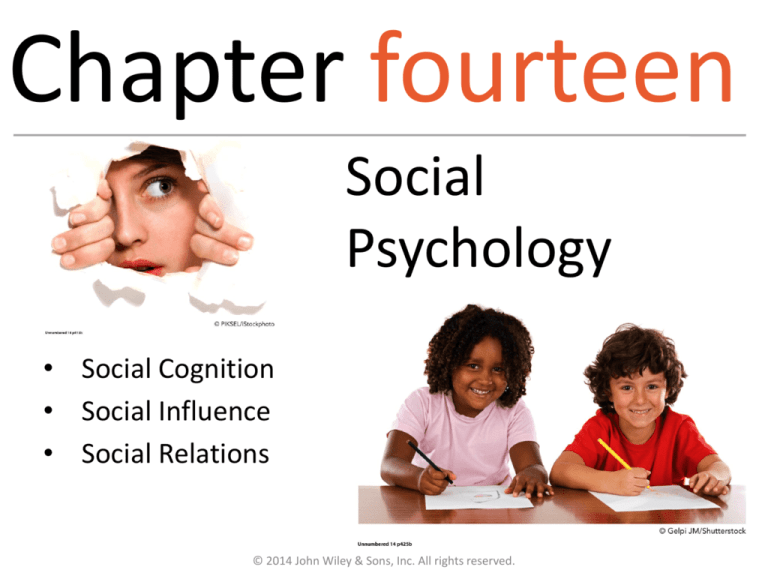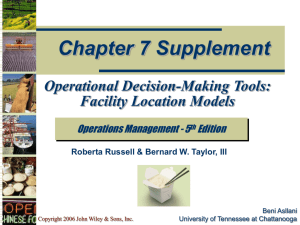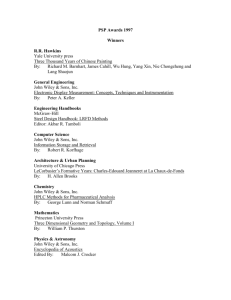
Chapter fourteen
Social
Psychology
• Social Cognition
• Social Influence
• Social Relations
© 2014 John Wiley & Sons, Inc. All rights reserved.
realworldpsychology
Things You’ll Learn in Chapter 14
Q1
Q2
Q3
Why do athletes often blame their game losses on
bad officiating?
If popular high school students are anti-drinking,
does that reduce underage drinking among their
peers?
Why are women less likely than men to share their
opinions in a group?
Q4
Are men still more likely to get hired than equally
qualified women?
Q5
How does simple nearness (proximity) influence
attraction?
© 2014 John Wiley & Sons, Inc. All rights reserved.
© 2014 John Wiley & Sons, Inc. All rights reserved.
SOCIAL COGNITION
© 2014 John Wiley & Sons, Inc. All rights reserved.
Social Psychology
• Social psychology = the branch of psychology
that studies how others influence our
thoughts, feelings, and actions; it also studies
group and intergroup phenomena
• Social cognition = how we think about and
interpret ourselves and others
– One of the largest and most important subfields in
social psychology
© 2014 John Wiley & Sons, Inc. All rights reserved.
Attributions
• Attribution = a social-cognitive approach to describing
the ways a social perceiver uses information to generate
causal explanations; how we explain our own and
others’ actions
• Suppose a new classmate seems distant and
uninterested in interaction. Why?
– Is she stuck-up? – a dispositional (personality) attribution
– Is she nervous about being new? – an influence of the
situation
• Sometimes (often!) we make the wrong attribution
© 2014 John Wiley & Sons, Inc. All rights reserved.
Fundamental Attribution Error (FAE)
• Fundamental attribution error = the tendency of
observers to overestimate the influence of internal,
dispositional factors on a person’s behavior, while
underestimating the impact of external, situational
factors
• Why?
– People’s enduring personality traits and our tendency to take
cognitive shortcuts means we most often choose the
dispositional attribution (we blame the person)
– Saliency bias = a type of attributional bias in which people tend
to focus on the most noticeable (salient) factors when explaining
the causes of behavior
© 2014 John Wiley & Sons, Inc. All rights reserved.
Self-Serving Bias
• Self-serving bias = a type of attributional bias in
which people tend to take credit for their
successes and externalize or deny responsibility
for their failures
Q1
Why do athletes often blame their game
losses on bad officiating?
• Olympic athletes attributed their wins to
internal (personal) causes like skill and effort
and their losses to external (situational) causes,
such as bad officiating (Aldridge & Islam, 2012)
© 2014 John Wiley & Sons, Inc. All rights reserved.
Self vs others
• Fundamental Attribution Error is about others
• Self-serving bias is about self
© 2014 John Wiley & Sons, Inc. All rights reserved.
Culture and Attributional Biases
• In highly individualistic cultures like the U.S., people are
defined and understood as individual selves, responsible
for their own success and failures
• People in collectivistic cultures are defined as members
of social networks, responsible for doing as others
expect.
• In which culture is FAE most likely?
• Individualist cultures
• Self-serving bias is also less common in collectivistic
cultures because self-esteem is not related to doing
better than others
© 2014 John Wiley & Sons, Inc. All rights reserved.
Attitudes
• Attitudes = the learned predisposition to
respond cognitively, affectively, and
behaviorally to a particular object, person,
place, thing, or event in an evaluative way
• The ABCs of attitudes:
– Affect (feelings)
– Behavior (actions)
– Cognitions (thoughts and beliefs)
© 2014 John Wiley & Sons, Inc. All rights reserved.
Attitude Formation
• We learn attitudes through direct
instruction, personal experiences, and
observation
• Showing women 100
pictures of plus-size
models caused them to
change their initial
attitude, which had been
to prefer the thin ideal
© 2014 John Wiley & Sons, Inc. All rights reserved.
Attitude Change
• One effective way to change attitudes is through
cognitive dissonance = the unpleasant tension and
anxiety caused by a discrepancy between an attitude
and a behavior
• Festinger and Carlsmith (1959): participants were paid
either $1 or $20 to lie to other participants about how
fun the experiment is.
© 2014 John Wiley & Sons, Inc. All rights reserved.
How cognitive dissonance changes attitudes
• Cognitive dissonance
creates discomfort
• Need to reduce
discomfort by changing
behavior or attitude
• Changing behavior is
harder than changing
attitude
Quit
smoking
“I don’t smoke that much”
“I eat healthy, so smoking is ok”
“There’s no evidence that
smoking is bad”
© 2014 John Wiley & Sons, Inc. All rights reserved.
SOCIAL INFLUENCE
© 2014 John Wiley & Sons, Inc. All rights reserved.
Social Influence
• Social influence = how situational factors and
other people affect us
• Three key topics
– Conformity
– Obedience
– Group processes
© 2014 John Wiley & Sons, Inc. All rights reserved.
Conformity
• Conformity = changes in behavior, attitudes,
or values because of real or imagined group
pressure
• Solomon Asch’s study of conformity
• More than 1/3 of
participants
conformed and
went along with
the group’s
wrong answers
© 2014 John Wiley & Sons, Inc. All rights reserved.
Conformity
• Three factors that drive conformity
1. Normative social influence = conformance to group
pressure out of a need to be liked, accepted, and
approved by others
2. Informational social influence = conformance to a
group out of a need for information and direction
3. Reference groups = the people we conform to, or go
along with, because we like, admire, and want to be
like them
© 2014 John Wiley & Sons, Inc. All rights reserved.
Reference Group
Q2
If popular high school students are anti-drinking,
does that reduce underage drinking among their
peers?
• Popular high school students’ attitudes
about alcohol substantially influence
other students; peers with negative
attitudes were more influential in
determining rates of teenage drinking
than those with positive attitudes
(Teunissen et al., 2012)
© 2014 John Wiley & Sons, Inc. All rights reserved.
Value of Conformity and Obedience
• Obedience = following direct commands,
usually from an authority figure
• Conformity and obedience are not always bad
In what ways
are conformity
obedience
adaptive and
helpful?
© 2014 John Wiley & Sons, Inc. All rights reserved.
Obedience
• Milgram study : would participants assigned as
“teachers” obey the experimenter’s commands to
shock the “learners” for wrong answers?
• 25% of people surveyed said
they would shock past 150
volts
• But 65% of participants
obeyed completely and
delivered shocks to XXX level
© 2014 John Wiley & Sons, Inc. All rights reserved.
Milgram
• Important: no one was actually shocked! The
“learner” was a confederate and was not
actually hooked to a shock generator
• Immediately after the study, the participants
were debriefed
• Study could not be replicated today due to
ethical research standards
© 2014 John Wiley & Sons, Inc. All rights reserved.
Follow-up Milgram Studies
© 2014 John Wiley & Sons, Inc. All rights reserved.
Milgram
Why did participants follow orders?
• Legitimacy and closeness of authority
• Remoteness of the victim
• Assignment of responsibility
• Modeling or imitation of others
• Socialization to the authority figure
• Foot-in-the-door technique = an initial, small request is
used as a setup for a later, larger request
• Relaxed moral guard: evil doesn’t always “look” evil
© 2014 John Wiley & Sons, Inc. All rights reserved.
Group Processes
• Zimbardo prison study: two-week
study at Stanford
– Half were assigned role of “guard”
– Half were assigned role of “prisoner”
• The study was stopped after only six days because
“guards” abused their role of power and “prisoners”
suffered severe psychological responses.
• Deindividuation = the reduced self-consciousness,
inhibition, and personal responsibility that sometimes
occurs in a group, particularly when members feel
anonymous
© 2014 John Wiley & Sons, Inc. All rights reserved.
Group Decision Making
• Decisions made in a group experience riskyshift phenomenon: the group supports a
riskier outcome together than they would
have determined individually
• But sometimes results are more conservative:
• Group polarization = the tendency for groups
to make decisions that are more extreme
(either riskier or more conservative)
depending on the members’ initial dominant
tendency
© 2014 John Wiley & Sons, Inc. All rights reserved.
Group Decision Making
• We perceive information that agrees with our
initial position, exaggerating our feelings of
being correct
• Groupthink = the faulty decision making that
occurs when a highly cohesive group strives
for agreement, especially if it is line with the
leader’s viewpoint, and avoids inconsistent
information
© 2014 John Wiley & Sons, Inc. All rights reserved.
Group Decision Making
In what situations might
group polarization and
group think be especially
dangerous?
Q3
Why are women less likely than men to share their
opinions in a group?
• Women are especially likely to refrain from speaking
up in a group setting, so their opinions are less likely
to be heard than men’s (Karpowitz et al., 2012)
© 2014 John Wiley & Sons, Inc. All rights reserved.
SOCIAL RELATIONS
© 2014 John Wiley & Sons, Inc. All rights reserved.
Social Relations
• Social relations = how we develop and are
affected by interpersonal relationships
• Kurt Lewin (1890–1947) is considered the “father
of social psychology” because of his emphasis on
this area
• Topics include:
–
–
–
–
Prejudice
Aggression
Altruism
Interpersonal attraction
© 2014 John Wiley & Sons, Inc. All rights reserved.
Prejudice and Discrimination
Prejudice is an attitude; discrimination is a behavior
• Prejudice = a learned, generally negative attitude
toward members of a group; it includes thoughts
(stereotypes), feelings, and behavioral tendencies
(possible discrimination)
• Stereotypes = generalizations about a group of people
in which the same characteristics are assigned to all
members of the group; also, the cognitive component
of prejudice
• Discrimination = negative behaviors directed at others
because of their membership in a particular group
© 2014 John Wiley & Sons, Inc. All rights reserved.
Source of Prejudice and Discrimination
1. Learning
• Prejudice (like other attitudes) is learned
through classical and operant conditioning
and social learning
2. Personal experience
• One or more negative experiences with a
member of a specific group can cause
negative feelings to be generalized to all
members of the group
© 2014 John Wiley & Sons, Inc. All rights reserved.
Source of Prejudice and Discrimination
3. Limited resources
• Prejudice and discrimination provide significant
power and privilege to the majority group
4. Displaced aggression
• Frustration can cause aggression, but if the
source of the frustration is ambiguous or
unavailable (economic constraint, loss of
power), the aggression can be displaced onto a
scapegoat – an alternate innocent target
© 2014 John Wiley & Sons, Inc. All rights reserved.
Source of Prejudice and Discrimination
5. Mental shortcuts
• Stereotypes are tool to simplify complex social
world and free up mental resources for other
activity
Q4
Are men still more likely to get hired than equally
qualified women?
• Both male and female science faculty
who received identical resumés
chose the candidate with the male
name (Moss-Racusin et al., 2012)
© 2014 John Wiley & Sons, Inc. All rights reserved.
Sources of Prejudice and Discrimination
• Prejudice can occur without conscious
awareness
• Implicit bias = a hidden, automatic attitude
that may guide behaviors independent of a
person’s awareness or control
– Implicit Association Test (IAT)
© 2014 John Wiley & Sons, Inc. All rights reserved.
Sources of Prejudice and Discrimination
• Ingroup favoritism = viewing
members of the ingroup more
positively than members of
an outgroup
• Outgroup homogeneity
effect = judging members of
an outgroup as more alike
and less diverse than
members of the ingroup
© 2014 John Wiley & Sons, Inc. All rights reserved.
Does anyone
have a favorite
sports team?
How do you feel
about fans of the
rival team?
Overcoming Prejudice
1. Cooperation and common goals
• Sherif summer camp study: boys were assigned to
different cabins, competitive games increased
prejudice between cabins, prejudice was decreased
with cooperative projects (with superordinate goals
that could only be achieved together)
2. Intergroup contact
• Situation must include close
interaction, interdependence, and
equal status
© 2014 John Wiley & Sons, Inc. All rights reserved.
Overcoming Prejudice
3. Cognitive Retraining
• Pay attention to similarities rather than differences,
practice taking the other person’s perspective
4. Cognitive Dissonance
• Meeting someone who does not conform to
stereotypical views creates cognitive dissonance. The
initial response may be “this is an exception to the
rule”, but over time the stereotype breaks down
© 2014 John Wiley & Sons, Inc. All rights reserved.
Aggression
• Aggression = any behavior intended to cause
psychological or physical harm to another
individual
© 2014 John Wiley & Sons, Inc. All rights reserved.
Biological Explanations
• Twin studies show some people are
genetically predisposed to hostility
• Research on brain injury and disorders has
identified possible aggression circuits in the
brain
• Studies have linked male hormone
testosterone and lowered levels of some
neurotransmitters to aggressive behavior
© 2014 John Wiley & Sons, Inc. All rights reserved.
Psychological Explanations
• Environmental stimuli can cause aggression (alcohol,
noise, pain, bullying, insults)
• Frustration-aggression hypothesis = a hypothesis that
states that the blocking of a desired goal (frustration)
creates anger that may lead to aggression
• Exposure to violence increases aggression (and
aggressive children seem to seek out more violent
media)
• Social-learning theory says culture with aggressive
models will leads to more aggression
© 2014 John Wiley & Sons, Inc. All rights reserved.
Decreasing Aggression
• Some suggest catharsis can decrease
aggression – release aggressive impulses
through harmless forms of aggression, like
punching a pillow or watching aggressive
sports.
• Studies show catharsis doesn’t help decrease
aggression and may only intensify the feelings
• Introduce incompatible responses – empathy
and humor are incompatible with aggression
© 2014 John Wiley & Sons, Inc. All rights reserved.
Altruism
• Altruism = prosocial behaviors designed to help
others, with no obvious benefit to the helper
• Why do we help others?
© 2014 John Wiley & Sons, Inc. All rights reserved.
When and Why Don’t We Help?
© 2014 John Wiley & Sons, Inc. All rights reserved.
When and Why Don’t We Help?
• Bystander effect = a phenomenon in which
the greater the number of bystanders, the less
likely it is that any one individual will feel
responsible for seeking help or giving aid to
someone in need of help
• Why? When others are around, we share the
responsibility to help (or not) through
diffusion of responsibility
© 2014 John Wiley & Sons, Inc. All rights reserved.
Interpersonal Attraction
• Interpersonal attraction = positive feelings
toward another
• Three factors:
– Physical attractiveness
– Proximity
– Similarity
© 2014 John Wiley & Sons, Inc. All rights reserved.
Physical Attractiveness
• Attractive people are seen as more poised,
interesting, cooperative, intelligent, healthy…
• Standards for attractiveness are consistent
across cultures:
• Women are valued more for looks and youth
– Suggest better health and higher fertility
• Men are valued more for ambitiousness and
financial resources
– Better able to provide for mate and offspring
© 2014 John Wiley & Sons, Inc. All rights reserved.
Proximity
• Likelihood of friendship decreases as distance
between people increases (even on Facebook!)
Q5
How does simple nearness (proximity)
influence attraction?
• Oxytocin stimulated men in monogamous
relationships to keep larger distance between
themselves and attractive women compared to
single men (Scheele et al., 2012)
© 2014 John Wiley & Sons, Inc. All rights reserved.
Proximity
• Mere-exposure effect = a developed
preference for people or things simply
because they are familiar
• Repeated exposure increases liking
• From an evolutionary perspective, the safest
stimuli are the most common
• Advertisers use this by repeatedly running
familiar ads
© 2014 John Wiley & Sons, Inc. All rights reserved.
Similarity
• We tend to prefer and stay with people who
are most like us – share our ethnic
background, social class, interests and
attitudes
• Birds of a feather flock together
© 2014 John Wiley & Sons, Inc. All rights reserved.
Loving Others
• Sternberg’s triarchic theory of love
© 2014 John Wiley & Sons, Inc. All rights reserved.
Romantic Love
• Companionate love = strong and
lasting attraction characterized by
trust, tolerance, and friendship –
slowly develops as couples grow and
spend more time together
• Romantic love = an intense feeling of
attraction to another in an erotic
context – largely based on mystery
and fantasy and generally begins to
fade 6 to 30 months into the
relationship
© 2014 John Wiley & Sons, Inc. All rights reserved.
© 2014 John Wiley & Sons, Inc. All rights reserved.







